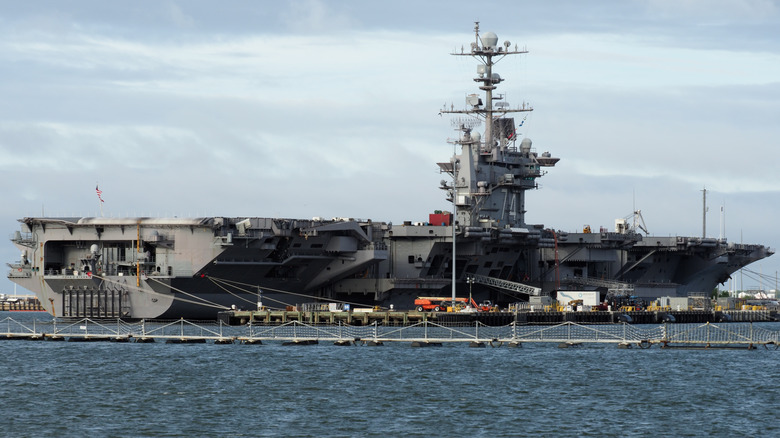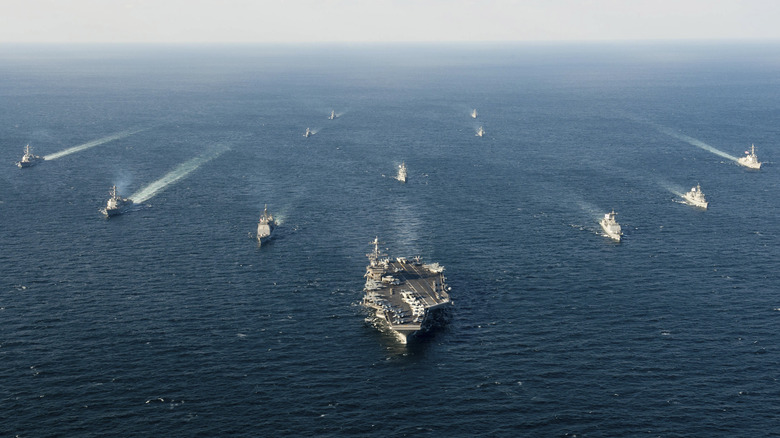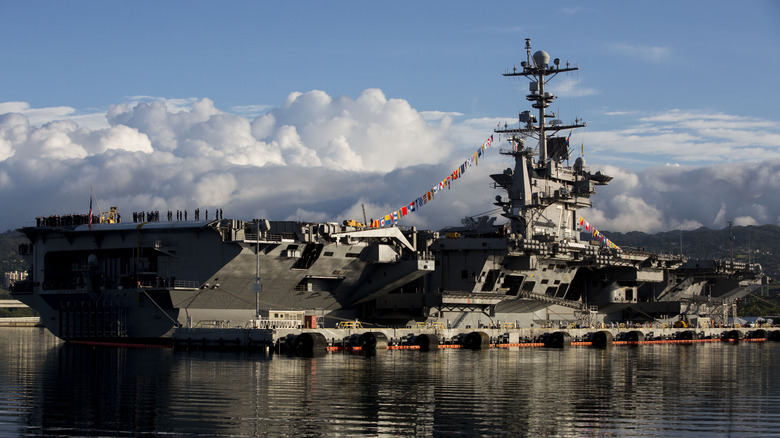What's The Status Of The USS John C. Stennis (CVN 74) & What's The Vessel's Nickname?
In the 100+ years since the United States fielded its first aircraft carrier, the nation has launched a ton of similar vessels. Of the many aircraft carriers operated by the U.S. throughout this time, few are as controversial as the USS John C. Stennis (CVN-74), also known as Johnny Reb. To be clear, the vessel itself nor her personnel are controversial — it's the name that makes people take notice, and not in a good way. The Stennis is named after former U.S. Senator John C. Stennis of Mississippi.
While it's certainly an honor to have a ship named after an important person, Stennis was a controversial figure. As a result, when President Ronald Reagan approved the name for the seventh Nimitz-class supercarrier, a lot of people complained. The ship was commissioned on December 9, 1995, and it's remained a polarizing vessel ever since. On its own, the Stennis is an excellent naval vessel with a proud history of supporting U.S. operations abroad.
She began a modernization refueling and complex overhaul (RCOH) in 2021 and currently remains at her home port of Norfolk, Virginia, though her refit has been delayed 14 months to October 2026. While that's all well and good, the name is a sticking point for a lot of people, as Senator Stennis was a die-hard segregationist. That has led to many people asking for the ship to be renamed, including some of the men and women who currently serve or previously served aboard the USS John C. Stennis.
Johnny Reb
The controversial decision to name CVN-74 after Senator Stennis revolves around his staunch opposition to desegregation. Because of this, the vessel earned the less-than-flattering nickname Johnny Reb. This isn't a moniker adopted by the late Senator; instead, it refers to soldiers in the Confederate States of America. While U.S. soldiers are often called Joes or G.I. Joes, Confederate soldiers were known as Johnny Reb — a common soldier in the Confederate Army.
Referring to the Stennis as Johnny Reb is a fair name to apply, as the Senator was not in favor of racial equality. Throughout his 41 years in the Senate, Stennis voted against or actively opposed everything from the Civil Rights Act of 1964 and its successor the following year to the Civil Rights Act of 1968, and he voted against the establishment of Martin Luther King Jr. Day as a federal holiday. It's fair to say that Senator Stennis would likely not appreciate the fact that a ship bearing his name is manned by personnel from all races.
Following the murder of George Floyd, many Americans voiced their distaste for naming ships, schools, and bases after people like Senator Stennis. Retired Lt. Cdr. Reuben Keith Green wrote, "I often have thought about what it must be like for a minority sailor to receive orders and serve in the USS John C. Stennis. Most sailors — and Navy leaders — have little idea of his background, but the Navy, as an institution, has a moral obligation to know."
The USS John C. Stennis' RCOH
President Reagan didn't name CVN-74 after Senator Stennis because they were pals; he did it because Stennis was an important figure in naval modernization. He earned the title "Father of the Modern Navy" for his efforts to approve the building of nuclear aircraft carriers and submarines. That's certainly an important aspect of Stennis' life as a public servant, but regardless of his work with the Navy, it's difficult to look beyond Stennis' leanings.
The ship may receive a new name and it may not — that's not something that can be accomplished easily or without the work of Congress. Regardless, the USS John C. Stennis remains an active carrier in the U.S. Navy, and thanks to its current RCOH, it will continue to serve for years to come. The life of a Nimitz-class carrier is around 50 years, and the RCOH ensures the Stennis will continue sailing until around 2045, when it hits that 50-year mark.
The Stennis' RCOH is delayed due to a ship condition assessment, indicating that more repairs were needed than initially believed. It was meant to return to service in August 2025, but the delay pushed the timeline to October 2026. The RCOH involves extensive upgrades and the refueling of the carrier's nuclear power plant. Additionally, it will receive modernization hardware and software upgrades to bring the 20th-century supercarrier into the 21st century.


